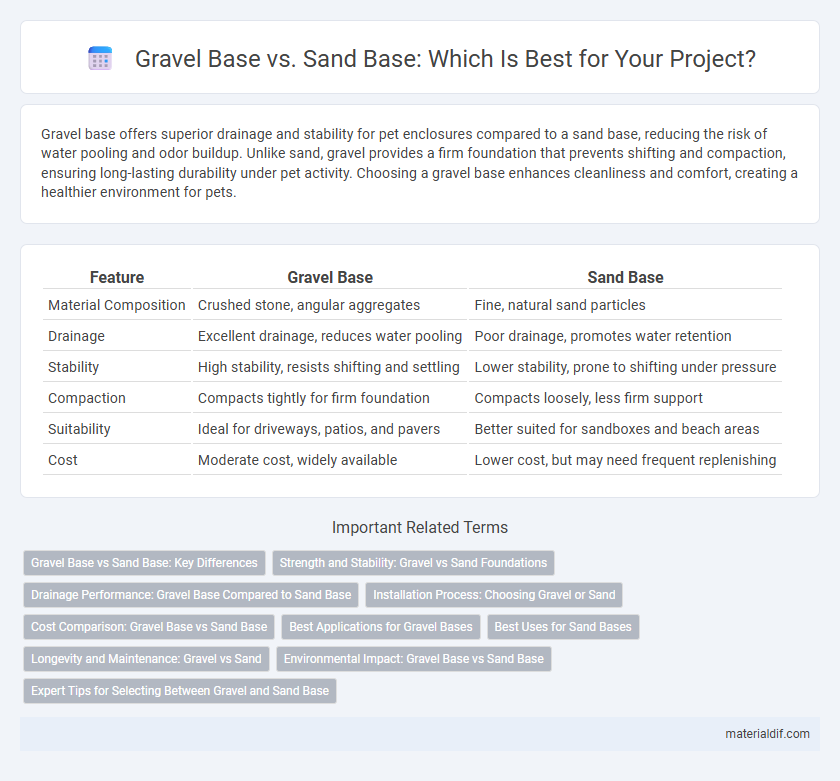Gravel base offers superior drainage and stability for pet enclosures compared to a sand base, reducing the risk of water pooling and odor buildup. Unlike sand, gravel provides a firm foundation that prevents shifting and compaction, ensuring long-lasting durability under pet activity. Choosing a gravel base enhances cleanliness and comfort, creating a healthier environment for pets.
Table of Comparison
| Feature | Gravel Base | Sand Base |
|---|---|---|
| Material Composition | Crushed stone, angular aggregates | Fine, natural sand particles |
| Drainage | Excellent drainage, reduces water pooling | Poor drainage, promotes water retention |
| Stability | High stability, resists shifting and settling | Lower stability, prone to shifting under pressure |
| Compaction | Compacts tightly for firm foundation | Compacts loosely, less firm support |
| Suitability | Ideal for driveways, patios, and pavers | Better suited for sandboxes and beach areas |
| Cost | Moderate cost, widely available | Lower cost, but may need frequent replenishing |
Gravel Base vs Sand Base: Key Differences
Gravel base provides superior drainage and load-bearing capacity compared to a sand base, making it ideal for heavy-duty construction and road foundations. Sand base offers easier compaction and smoother leveling but lacks the structural stability and water filtration benefits of gravel. Choosing between gravel base and sand base depends on project requirements such as drainage, foundation strength, and environmental conditions.
Strength and Stability: Gravel vs Sand Foundations
Gravel bases provide superior strength and stability compared to sand foundations due to their excellent drainage properties and interlocking particle structure, which distributes loads evenly and minimizes shifting. Sand bases often compact unevenly, risking settling and weakening the foundation over time, especially under heavy loads or moisture exposure. Engineering projects favor gravel for durable foundations, as its rigidity and resistance to water erosion ensure long-term structural integrity.
Drainage Performance: Gravel Base Compared to Sand Base
Gravel base offers superior drainage performance compared to sand base due to its larger particle size and increased permeability, allowing water to flow through quickly and reducing the risk of pooling or erosion. Unlike sand, which can compact and retain moisture, gravel maintains consistent drainage channels that promote faster water runoff and prevent saturation. This makes gravel base ideal for applications requiring efficient water management, such as pathways, patios, and roadbeds.
Installation Process: Choosing Gravel or Sand
Gravel base installation involves compacting layers of coarse aggregate to create a stable, permeable foundation ideal for driveways and patios, ensuring excellent drainage and load distribution. Sand base installation requires leveling fine sand that provides a smooth, uniform surface but may need additional layers or edging to prevent shifting under heavy loads. Selecting gravel over sand depends on project durability requirements, drainage needs, and soil conditions, with gravel offering superior strength and water management.
Cost Comparison: Gravel Base vs Sand Base
Gravel base typically costs between $1 and $3 per square foot, making it a more affordable option compared to sand base, which ranges from $2 to $4 per square foot. Gravel's lower price is due to its abundance and easier installation process, while sand base requires more labor and material processing, increasing overall expenses. Choosing gravel base can reduce project costs by up to 50%, especially for large-scale applications like driveways and patios.
Best Applications for Gravel Bases
Gravel bases provide superior drainage and load-bearing capabilities, making them ideal for driveways, patios, and walkways where water runoff must be controlled. Unlike sand bases, gravel bases resist compaction and shifting under heavy traffic, ensuring long-term stability for outdoor structures. Their angular shape interlocks to create a firm foundation, reducing maintenance needs compared to sand-based installations.
Best Uses for Sand Bases
Sand bases excel in applications requiring superior drainage and stability, such as under patios, pool decks, and sports courts, where water runoff must be efficiently managed. Their fine particles create a compact yet permeable foundation, preventing shifting and settling over time. Compared to gravel bases, sand bases provide smoother surfaces ideal for pavers and tiles, enhancing both structural integrity and aesthetic appeal.
Longevity and Maintenance: Gravel vs Sand
Gravel base offers superior longevity compared to sand base due to its excellent drainage properties and resistance to compaction, reducing the risk of erosion and shifting over time. Maintenance of a gravel base is generally easier, requiring less frequent replenishment and grading, whereas sand bases often demand regular additions and leveling to prevent settling and uneven surfaces. Gravel resists moisture retention better, minimizing weed growth and freeze-thaw damage, which further extends its durability and reduces upkeep costs.
Environmental Impact: Gravel Base vs Sand Base
Gravel base provides superior drainage, reducing water runoff and erosion compared to sand base, which tends to retain moisture and potentially cause groundwater contamination. Gravel's porous structure promotes natural water filtration, minimizing environmental harm from pollutants. Conversely, sand base compaction can disrupt soil ecosystems, whereas gravel supports sustainable landscaping by preserving soil biodiversity.
Expert Tips for Selecting Between Gravel and Sand Base
Gravel base offers superior drainage and stability, making it ideal for heavy-load areas like driveways and patios, while sand base provides a smoother surface, better suited for pavers and delicate landscaping projects. Experts recommend assessing soil type, load requirements, and moisture conditions to determine the optimal base material, emphasizing that gravel prevents settling and erosion better than sand. Choosing the right base enhances durability and longevity, minimizing maintenance and structural issues over time.
Gravel Base vs Sand Base Infographic

 materialdif.com
materialdif.com